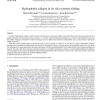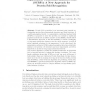516 search results - page 63 / 104 » Prediction of Protein Function Using Protein-Protein Interac... |
BMCBI
2010
13 years 5 months ago
2010
Background: Colon cancer is driven by mutations in a number of genes, the most notorious of which is Apc. Though much of Apc's signaling has been mechanistically identified o...
BMCBI
2006
13 years 7 months ago
2006
Background: There are several isolated tools for partial analysis of microarray expression data. To provide an integrative, easy-to-use and automated toolkit for the analysis of A...
BMCBI
2010
13 years 7 months ago
2010
Background: Efficient dissection of large proteins into their structural domains is critical for high throughput proteome analysis. So far, no study has focused on mathematically ...
CANDC
2006
ACM
13 years 7 months ago
2006
ACM
A model of hydrophobic collapse, which is treated as the driving force for protein folding, is presented. This model is the superposition of three models commonly used in protein ...
RECOMB
2005
Springer
14 years 8 months ago
2005
Springer
Abstract. Protein fold recognition is an important step towards understanding protein three-dimensional structures and their functions. A conditional graphical model, i.e. segmenta...


